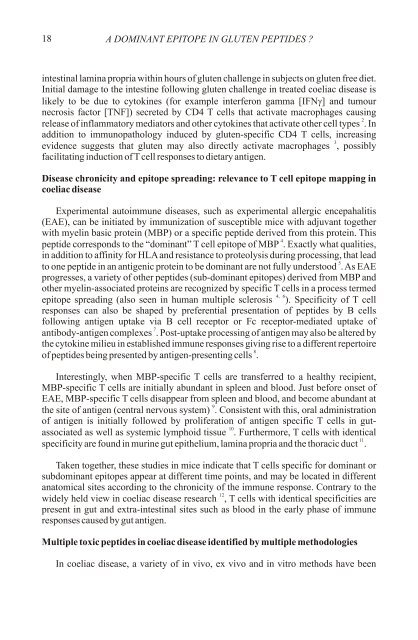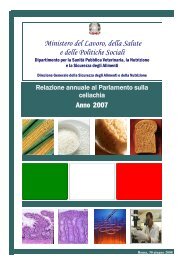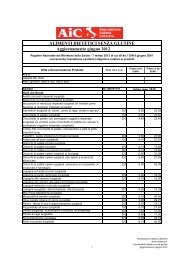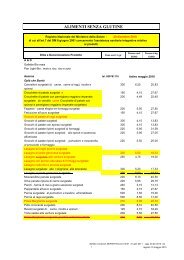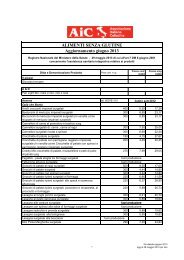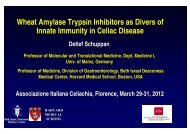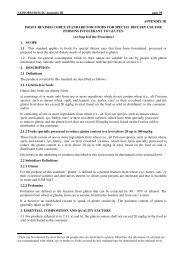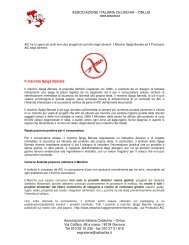primary prevention of coeliac disease - Associazione Italiana ...
primary prevention of coeliac disease - Associazione Italiana ...
primary prevention of coeliac disease - Associazione Italiana ...
Create successful ePaper yourself
Turn your PDF publications into a flip-book with our unique Google optimized e-Paper software.
18<br />
A DOMINANT EPITOPE IN GLUTEN PEPTIDES ?<br />
intestinal lamina propria within hours <strong>of</strong> gluten challenge in subjects on gluten free diet.<br />
Initial damage to the intestine following gluten challenge in treated <strong>coeliac</strong> <strong>disease</strong> is<br />
likely to be due to cytokines (for example interferon gamma [IFNg] and tumour<br />
necrosis factor [TNF]) secreted by CD4 T cells that activate macrophages causing<br />
2<br />
release <strong>of</strong> inflammatory mediators and other cytokines that activate other cell types . In<br />
addition to immunopathology induced by gluten-specific CD4 T cells, increasing<br />
3<br />
evidence suggests that gluten may also directly activate macrophages , possibly<br />
facilitating induction <strong>of</strong> T cell responses to dietary antigen.<br />
Disease chronicity and epitope spreading: relevance to T cell epitope mapping in<br />
<strong>coeliac</strong> <strong>disease</strong><br />
Experimental autoimmune <strong>disease</strong>s, such as experimental allergic encepahalitis<br />
(EAE), can be initiated by immunization <strong>of</strong> susceptible mice with adjuvant together<br />
with myelin basic protein (MBP) or a specific peptide derived from this protein. This<br />
4<br />
peptide corresponds to the “dominant” T cell epitope <strong>of</strong> MBP . Exactly what qualities,<br />
in addition to affinity for HLA and resistance to proteolysis during processing, that lead<br />
5<br />
to one peptide in an antigenic protein to be dominant are not fully understood . As EAE<br />
progresses, a variety <strong>of</strong> other peptides (sub-dominant epitopes) derived from MBP and<br />
other myelin-associated proteins are recognized by specific T cells in a process termed<br />
4, 6<br />
epitope spreading (also seen in human multiple sclerosis ). Specificity <strong>of</strong> T cell<br />
responses can also be shaped by preferential presentation <strong>of</strong> peptides by B cells<br />
following antigen uptake via B cell receptor or Fc receptor-mediated uptake <strong>of</strong><br />
7<br />
antibody-antigen complexes . Post-uptake processing <strong>of</strong> antigen may also be altered by<br />
the cytokine milieu in established immune responses giving rise to a different repertoire<br />
8<br />
<strong>of</strong> peptides being presented by antigen-presenting cells .<br />
Interestingly, when MBP-specific T cells are transferred to a healthy recipient,<br />
MBP-specific T cells are initially abundant in spleen and blood. Just before onset <strong>of</strong><br />
EAE, MBP-specific T cells disappear from spleen and blood, and become abundant at<br />
9<br />
the site <strong>of</strong> antigen (central nervous system) . Consistent with this, oral administration<br />
<strong>of</strong> antigen is initially followed by proliferation <strong>of</strong> antigen specific T cells in gut-<br />
10<br />
associated as well as systemic lymphoid tissue . Furthermore, T cells with identical<br />
11<br />
specificity are found in murine gut epithelium, lamina propria and the thoracic duct .<br />
Taken together, these studies in mice indicate that T cells specific for dominant or<br />
subdominant epitopes appear at different time points, and may be located in different<br />
anatomical sites according to the chronicity <strong>of</strong> the immune response. Contrary to the<br />
12<br />
widely held view in <strong>coeliac</strong> <strong>disease</strong> research , T cells with identical specificities are<br />
present in gut and extra-intestinal sites such as blood in the early phase <strong>of</strong> immune<br />
responses caused by gut antigen.<br />
Multiple toxic peptides in <strong>coeliac</strong> <strong>disease</strong> identified by multiple methodologies<br />
In <strong>coeliac</strong> <strong>disease</strong>, a variety <strong>of</strong> in vivo, ex vivo and in vitro methods have been


